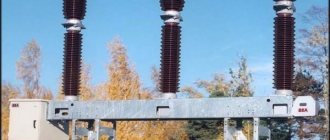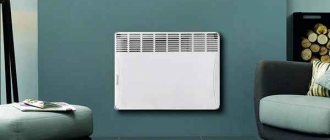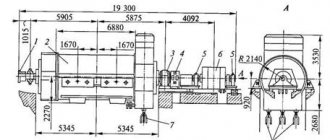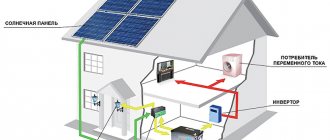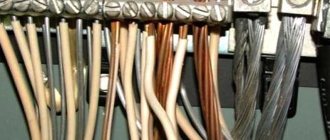The main regulatory document regulating the reliable, coordinated operation of energy facilities that gives the highest economic effect is the PTE of power plants and networks. They spell out all the nuances that apply to organizational and technical tasks that arise during the construction, launch and operation of energy structures.
PTEEESS RF
Operation of power plants and networks
In the rules for the technical operation of power plants and networks (PTEESS), one of the provisions addresses issues such as:
- launch and acceptance of newly built installations and structures;
- basic requests for service personnel;
- creating control over the efficiency of processes;
- technical control over the operation of electrical installations and power plants;
- repair, maintenance work and equipment modernization;
- maintaining technical documentation;
- ACS devices (automatic control systems).
The set of rules also includes a unified regulation for making measurements throughout the Russian energy system.
Power system of Russia, diagram
Rules for acceptance of structures and equipment into operation
Attention! The rules of this section considered in the Ptess include tasks imposed on newly built or technically refurbished structures and equipment.
Before talking about acceptance, you need to know what the start-up complex (power facility) is.
Launch complex
Important! During the process of construction or re-equipment, intermediate tests of both components and hidden work must be carried out.
Verification of compliance with the 2003 PTE before operational tests is mandatory.
All detected deficiencies, installation or construction defects identified during the inspection must be eliminated before the start of comprehensive testing.
Comprehensive testing
For your information. Normal uninterrupted operation of the main equipment for 72 hours with a load equal to the rated load is considered a comprehensive test. For power lines (PTL), the time interval is 24 hours.
Rules requirements for personnel
When staffing teams of repair, maintenance and operational dispatch personnel, a number of requirements are met.
Personnel requirements
Necessarily. In case of violations of these Rules, each employee is obliged to inform his immediate supervisor and try to eliminate the violations independently. Studying and following safety rules is the responsibility of the employee.
Ways to control the efficiency of energy facilities
In order to control the productivity of power plants (thermal or hydropower plants), developed energy parameters are used. The graphs, tables and annexes show the dependence of thermal and electrical loads on the economic and technical performance indicators of the equipment. To these can be added graphs of the consumption rates of raw materials (water or fuel) required to generate the supplied energy.
Information. The need to develop such characteristics for zoned boiler houses and low-power power plants is established by the regional JSC Energo.
Technical supervision of the operation of energy facilities
Technical supervision for inspections, technical examinations and surveys is established by relevant orders for the enterprise.
Technical Supervision
Important! The commission must assess the condition and outline measures to maintain and ensure the approved resource of the installation.
Modernization, repair and maintenance (TO)
Due to the wear and tear of buildings, structures and electrical equipment during operation, the problem of repair and replacement of worn-out components arises. Due to the specific nature of energy production, unplanned or emergency downtime (with complete or partial loss of power) entails great damage to consumers.
Attention! Unexpected shutdown of failed equipment leads to its damage. In addition, an emergency situation can threaten the life and health of personnel servicing the system.
To prevent this from happening, the following must be planned:
- modernization – replacement of obsolete equipment with new, more modern equipment;
- scheduled repairs: major (has the goal of restoring the full working life of the installation with the replacement of basic components) and current (maintaining the operation of the installation within the specified parameters with the replacement of wearing parts);
- maintenance – work not related to repairs (walk-throughs, inspections, lubrication, identification of deviations from the norm, replacement of consumables).
A separate section in the Rules deals with the reconstruction of facilities, which entails:
- increase in power;
- reduction of labor costs;
- reduction in material consumption.
Reconstruction leads to improved production performance and reduced energy costs.
An example of a power plant's maintenance schedule
Technical documentation of the power facility
Every enterprise in the energy industry must have a set of documentation.
List of documentation
In addition, there must be fire extinguishing and evacuation plans approved by fire authorities.
Automated control systems (ACS)
Allows you to control the operation of systems in automatic mode. A properly organized and implemented system makes it possible to optimize the number of staff and exercise control over the quality and operation of the facility.
Important! The implemented automated control system must be adaptively flexible to subsequent upgrades and various changes in application conditions.
Automated power facility control center
Unity of measurements
All measurements carried out in the energy sector must comply with the accuracy indicators accepted in Russia and be expressed in units used in the Russian Federation. This is necessary to ensure that all obtained results are comparable, regardless of time, place and measurement methods used.
5.3. SECTIONATION OF THE ELECTRICAL NETWORK
Sectioning an electrical network involves dividing power lines using switching devices into several sections. Partitioning can be non-automatic or automatic. Non-automatic partitioning refers to the division of the network using disconnectors and load switches that do not have automatic shutdown devices. Disconnectors are installed along the line at certain distances from each other and serve to section it in the process of searching for damage using the test switching method. Automatic sectioning is carried out by switching devices equipped with drives and automation devices, and in some cases with relay protection that acts to change the position of the devices under voltage or during a dead time. Devices designed for automatic operation divide power lines into parts. If damage occurs in the area between the installation site and the normal cut, such devices ensure that not the entire power line is disconnected, but only the damaged section, preserving power to consumers in the initial section. Rice. 5.3. Power supply diagram with local backup power sources: diesel power station - diesel power plant Switches equipped with protection and an automatic reclosure device (AR) are usually used as automatic sectioning devices. It is also permissible to use load switches equipped with protection that turn off during a dead time. They can also be used as switching devices on branches to localize faults without disconnecting the main power line. Current transformers required for protection can be simplified with open cores and installed on pin insulators. The primary winding is located on the neck of the insulator, and the secondary winding is located on the pin. The disadvantage of load switches when used as sectioning devices is that for test switching operations in the process of fault detection they can only be used as disconnectors. In the process of searching for faults using the test switching method, it is necessary to combine the operation of switches at the head sections of power lines with the actions of a mobile emergency team operating sectional disconnectors along the power lines. Due to the lack of permanent maintenance personnel in the central control room, and especially at the site where the sectional switch is installed, two teams have to be sent to search for damage: to the sectional switch and to the power line. Often this is not possible. Therefore, it is necessary to involve local personnel, at least from another department, in operating switches, equipping them with the necessary means of communication and using appropriate organizational forms. A radical way out of the situation is to equip all sectional switches with telemechanics, providing both telesignaling and remote control. However, due to the fact that turning off the switch in this case does not contain an element of visual confirmation of the operation, it is necessary to check the absence of voltage using indicators.
- Back
- Forward
Territory of power plants, requirements
Differential automatic machine reliable protection of electrical circuits and people
When arranging the territory, pay attention to the following points:
- implementation of surface water drainage;
- installation of noise-absorbing devices;
- organization of engineering structures: gas pipelines, sewerage, heating mains, water pipelines, etc.;
- execution of transport infrastructure: roads, approaches to fire reservoirs, pedestrian paths, bridges, etc.;
- installation of wells to control groundwater levels;
- security of the territory and arrangement of checkpoints (checkpoints).
Landscaping and landscaping are also included in a number of requirements.
Hydraulic structures of power plants
Methods of fire protection of electrical communications
PTE RF sets requirements for the reliability and safe operation of hydraulic structures. This is facilitated by drainage and anti-filtration devices and mechanisms. The rules emphasize service:
- dams and dams;
- drainage systems;
- berms and ditches.
Their long-term operation is ensured by the following conditions:
- protection from external influences;
- periodic condition monitoring.
All nuances related to the safe condition are transmitted in writing to supervisory structures.
Equipment of hydraulic structures
The valve equipment mechanisms are maintained in working order. During inspections (every 60 months), attention is paid to the following points:
- presence of a maximum opening height marker;
- absence of mechanical obstacles during operation;
- absence of vibrations, mechanical deformations, precise shrinkage on the threshold.
Ropes, alarms, grounding and wires are checked once every 12 months.
Dam gate
Water regime for power plants
Once every 10 years, the rules for the water regime of hydroelectric power plants are reviewed. There are two types of modes: working and special. The operating mode allows the use of water resources to ensure optimal plant load.
A special regime - before the spring flood, it includes:
- maximum (by level) filling;
- dumping excess water volume, with the ability to let ice and sediment through;
- the ability to maintain the normal functioning of irrigation and shipping.
In a special mode, additional control of water discharge occurs in order to ensure the safe operation of hydraulic structures.
Water discharge
Hydraulic structures in winter
Before the winter cold, they check the operation of the slush collectors and clean the sedimentation tanks for it. If hydraulic structures are not designed for ice pressure, then a hole is created in front of them. All winter it is cleared of ice.
For your information. Winter measurements of water temperature are carried out daily to determine when to turn on the heating for the grates. When the ice has not yet frozen, sludge can be passed through turbines or sludge dumps.
Power plant reservoir requirements
The rules describe in detail all the requirements for the location of water storage for hydroelectric power plants. The main activities include:
- allocation of a protective zone in which water use is limited;
- cleaning the reservoir from silt and thickets;
- protection of the coastline and its constant monitoring;
- laboratory sampling of water to analyze its quality;
- control of water temperature and ice condition in winter.
The rules oblige the implementation of environmental protection measures within the boundaries of the protection zone.
Reservoir protection zone
Hydro turbine units
These Rules regulate the uninterrupted operation of hydraulic turbines at rated load. At the same time, the efficiency (efficiency factor) is above average. If necessary, the installation must immediately switch to maximum load mode. This is ensured by a number of conditions:
- absolute automation of all hydroelectric power station units;
- possibility of stable operation with 100% open shutters;
- The synchronous compensatory mode of the hydraulic unit, if necessary, must immediately switch to the generator mode.
Attention! With three or more hydraulic units, GRAM (group active power control) is installed.
Technical water supply for power plants
Cooling towers are used to cool and distribute the water used. The walls of the devices have an anti-corrosion coating, which is cleaned once every two years to remove deposits. The waterproofing of the sheets is restored as necessary.
Water treatment measures
Organization of operation of distribution networks.
The main task of operating rural distribution networks is to carry out a number of measures to ensure an uninterrupted supply of high-quality electricity to consumers. The implementation of this task is entrusted to a number of services united in the electrical network enterprise (EPG). The main structural unit that operates distribution networks in an agricultural region is the electrical network district (RES). An approximate structure of operating services in the area is shown in Fig. 146. Electricity network districts (RES) are subordinate to sections of electrical networks (Uch. ES), which can perform the functions of RES with a small number of service facilities. The territory served by the Distribution Zone and Uch. ES should be limited to a radius of 40-50 km with an average density of distribution of consumers in the area and increases to 70-100 km with low density. Each district is subordinated to operational field teams (OVB), operational operational points (OEP) and repair and production bases (RPB), which can also be located in areas of electrical networks. Electrical network districts (RES) control the quality of overhauls of overhead lines and substations with a voltage of 35/6-10 kV, as well as transformer substations. Electrical network sections are engaged in operational maintenance, current and major repairs of lines with voltages up to 10 kV and consumer substations of 10/0.4 kV. Their functions also include eliminating accidents that occur among consumers. Operational field teams are stationed at the service center of the electrical network section. They also service 35/10 kV substations.
Rice. 146. Approximate structure for organizing the operation of distribution networks
Major repairs of substation equipment are carried out, as a rule, centrally, i.e. through the power grid area. However, if a rural substation is located a considerable distance from the distribution zone, it creates its own centralized repair team (CBR), which carries out repair work both at the substation itself and in power transmission lines with a voltage of 0.4-10 kV. Operational points are divided into two types: with a service area radius of up to 6-7 km and up to 10 km. The operation of lines with voltages up to 1000 V, internal wiring and electrical equipment installed in the production premises of collective and state farms is performed by collective and state farm electricians. In large farms, positions for electrical technicians and engineers are provided for this purpose. The relationship of personnel servicing internal power supply networks up to 1000 V for agricultural consumers with energy supply organizations of the USSR Ministry of Energy servicing external power supply networks is determined by the Standard Regulations. It is coordinated with the Ministry of Energy and the USSR Ministry of Agriculture and is mandatory for the personnel of electrical grid enterprises, as well as distribution zones, sites, branches of Energosbyt, as well as for all agricultural consumers of electricity.
Fuel and transport facilities of power plants
Installation of overhead electrical sockets
Network railway transport, supplying fuel by rail directly to the territory of the hydroelectric power station, must operate without interruption. The unloading process is completely mechanized. Pteesis RF is prescribed:
- control over the quality of raw materials;
- timely delivery to the station;
- keeping the areas adjacent to unloading clean.
Control equipment (scales, measuring instruments) must be calibrated and tested.
Fuel for power facility
Based on the type of fuel supplied to the power plant for operation, it is divided into the following types:
- hard;
- liquid;
- gaseous.
During the cold period, solid fuel is defrosted and loosened at unloading sites. According to the rules, this is carried out according to the regime map. Periodic sampling and checking the serviceability of mechanisms are regulated.
Liquid fuel is drained through a closed fuel line, filtered and supplied continuously. It is recommended to pay attention to the following questions:
- serviceability of devices;
- permissible fuel temperature range;
- viscosity;
- pressure;
- availability of a passport for the pipeline.
Fuel for storage must be taken from the upper layers of the tank contents. The frequency of monitoring the quality of stored stock can be developed locally.
Gaseous fuel is supplied to the burners of the units through a gas pipeline. All features of the organization and maintenance of the gas industry are regulated in detail in the Rules.
Thermal power plants, types of fuel
Thermomechanical equipment
The provision of each energy facility imposes special requirements for the reception and equipping of equipment in accordance with the functions during its maintenance. Thermomechanical equipment of power plants and heating networks is distributed among workshops, areas and laboratories, after which its operation by personnel begins. The key unit at stations of this type is the launch complex, which also includes production, auxiliary production, transport, household, auxiliary and repair equipment. Directly thermal mechanical installations include hot water and steam boiler units, steam turbine units, block systems of power plants and gas turbine devices. Each of the listed types of technical equipment has special operating requirements.
Power plants and networks, electrical equipment
Section PTE SO 153-34.20.501-2003 discusses:
- generators and synchronous compensators;
- electric motors;
- power transformers;
- reactors;
- voltage distribution devices.
The requirements for the technical operation of each item are considered from the point of view of safe, reliable and long-term operation.
Electrical requirements
Types of switches used in transformer substations
The substation operating instructions established by the manufacturer include requirements regarding regular checks of all elements of the air preparation system. According to the requirements of the manufacturer, the duration of operation of compressors with an operating pressure of 4.0 and 4.5 MPa (in another measurement system this parameter is equal to 40 and 45 kgf/cm2) should not exceed 30 minutes, and there cannot be a break in their operation less than 60 min. For more powerful devices of this type (23 MPa or 230 kg/cm2), both of these parameters equal one and a half hours. The air compressed by the compressor, intended for the operation of switching devices, is pre-dried using the thermodynamic method. The required degree of drying is achieved by creating a multiplicity in the pressure difference between the compressor and the switching device. Moreover, this difference for switching devices with a nominal operating pressure of 2 MPa or 20 kgf/cm2 must be at least two, and for more powerful devices (from 2.6 to 4.0 MPa) or from 26 kgf/cm2 to 40 kgf/cm2 this parameter must reach value equal to 4 units. If necessary, additional adsorption methods are used to dry the air passed through the compressor.
Moisture extracted from the air is collected in air collectors, from which it must be removed. For example, when using a compressor with a power of 4.0 to 4.5 MPa (40-45 kgf/cm2), it is recommended to do this procedure once every three days. The existing operating rules for compressor stations provide detailed information on how often this operation must be performed when using compressor equipment of a different capacity.
The bottom of the air collectors and the valve used to drain water must be insulated to prevent it from freezing. If freezing of the water removed from the air and collected in the air collector is still possible, then it is equipped with an electric heating device, which is turned on while the ice is melting.
When using a high-power compressor model - 23 MPa or 230 kgf/cm2, automatic removal of moisture from cylinders and condensate collectors is provided. To prevent liquid freezing, it is recommended that the bottoms of cylinders and condensate collectors be placed in heat-insulating chambers and equipped with an electrical heating device. This number does not include cylinders located in close proximity to the compressed air purification unit (CAU), the dehumidifier of which is subjected to purging procedures at least three times during the day.
The level of drying of the air leaving the dry air treatment plant is controlled by determining the dew point, that is, the temperature at which condensate moisture begins to be released from it. This parameter should not exceed -50 degrees. C. at a positive ambient temperature, and -40 degrees. C., if the temperature drops below zero.
According to the existing operating instructions, regular inspections of the condition of air collectors and compressor cylinders are carried out, as well as the necessary hydraulic tests. This is done in order to identify possible defects and to avoid an emergency. As for the internal inspection of air switches and other devices, it should be carried out during a major overhaul of all equipment of the transformer substation.
The reason for an unscheduled inspection, including hydraulic testing of air circuit breakers, is deviations in the operation of this equipment, or if the strength of its containers is in doubt. Air circuit breaker tanks must be coated to prevent corrosion.
The air compressed by the compressor is necessary for the functioning of all communication equipment, including the air switch. But before it gets into the above-mentioned devices, it undergoes a drying procedure and is freed from various solid particles using filtration. Cleaning filters are installed in switch cabinets or on the air duct drive. The rules for the technical operation of substations provide for the purging of all elements of the air preparation system after completion of its installation.
Similar precautions are taken on operating equipment. During the summer period, the following is purged: The main channels for the passage of air - at least once every two months.
Requirements for power cable lines
Ptess, as a manual for maintenance and repair, provides the following requirements:
- maintenance of power overhead and underground cable lines: power lines, subway and railway contact networks, etc.;
- providing climate control in cable channels;
- maintenance of cable routes;
- control over current load and core heating temperature.
Carefully! For cables with a service life of more than 15 years, current overload is permissible no higher than 10%. Overcurrent for paper-insulated cables operating at a voltage of 35 kV is unacceptable.
Compliance with Rules SO 153-34.20.501-2003 regulates all types of maintenance, repair and operation of energy facilities. Deviation from norms and recommendations entails emergency situations, equipment downtime, and threatens the health and life of operating personnel.
Operation of water heating and steam units
Personnel must ensure the safety and reliability of operation of boiler water and steam installations. In addition, during the maintenance process it is necessary to achieve the nominal performance of the units with acceptable characteristics of water and steam. Based on the instructions of the enterprise, thermal mechanical equipment of thermal power plants must be operated in an economical mode. This need is due not only to financial feasibility, but also to a more efficient and rational distribution of loads across individual parts of the unit. In particular, during the first time of operation of hot water and steam boilers, the pressure level should not exceed 9.8 MPa. If it is planned to increase this indicator in the future, then the main equipment, along with pipelines and adjacent components of the water-steam path, is subjected to chemical cleaning. Boilers whose optimal pressure level does not exceed 9.8 MPa are subjected to alkalization before commissioning.

